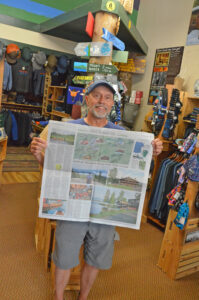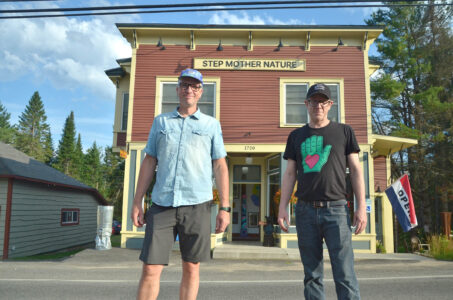Two caught in Wright Peak avalanche
Two skiers caught in an avalanche on the Angel Slides on Wright Peak this past Saturday were able to dig themselves out of the snow and walk away unharmed.
The perilous event was logged on Adirondack Community Avalanche Observations, a new website set up by local backcountry skiers to record avalanche activity and crowdsource potentially dangerous weather for public safety.
An ACAO user going by the name “Bryan” logged an avalanche he and another skier were swept up in at noon on Saturday. The Enterprise was not able to contact Bryan for this article.
Jeff Erenstone, who witnessed the avalanche and logged it in the ACAO, confirmed that a “Bryan” was one of the men caught in the avalanche.
Erenstone wrote that the wave of snow and ice “could bury and destroy a car, damage a truck, destroy a wood frame house, or break a few trees.”
“Everyone is fine but it was extremely close and people should be warned that the (back country) is still unstable and dangerous,” he wrote in a message.
Erenstone described it as a “massive human-triggered avalanche” of “wet and loose snow.”
Bryan wrote that he heard a “whoomp” 10 to 20 seconds before the snow collapsed on the slide around 500 feet above them.
“The entire slide released, an approximate width of 100′, and we estimate that it traveled 1,500 feet in total,” he wrote.
Bryan wrote they were carried around 150 feet in the wave of snow and buried. Bryan was only under a couple inches and was able to free himself quickly, but said his Garmin data shows he may have been under for a few minutes.
He found his skiing partner around 25 feet away using a backcountry access beacon.
“He was inverted and fully buried under 4-5 feet of snow,” Bryan wrote. “I was able to dig him out using my hands and (a) shovel. I estimate he was under for (10-15 min total).”
Bryan said his companion was not responsive immediately, but was breathing faintly.
“He regained consciousness after his face was exposed for a few minutes while I continued to free the rest of his body,” Bryan wrote.
Jeremy Knopp, who works at the Adirondack Mountain Club’s High Peaks Information Center at the Adirondak Loj, said the two skiers came in to report the avalanche after a four-hour hike down to the Loj. Knopp said they had lost a ski and three poles and had to posthole down through the snow to get out.
He said they were surprisingly calm and just wanted to make sure the DEC knew about the avalanche.
Knopp said the fresh snow and warm temperatures likely contributed to the conditions leading to the avalanche. They were uninjured, he said, but “lucky” they didn’t fall further where the cliffs and trees begin.
“No significant injuries were reported,” state Department of Environmental Conservation Forest Ranger Captain Christopher Kostoss wrote in an email. “Forest rangers were not called to respond.”
He said both skiers had the proper safety gear — shovels, beacons and transceivers — and they had practiced rescue techniques.
“DEC forest rangers are currently investigating the potential cause and/or conditions that led to the avalanche,” Kostoss wrote.
He said skiers, snowboarders and others in the backcountry should take “extreme caution” when on slides and steep terrain.
A DEC guide to avalanche avoidance and safety can be found at dec.ny.gov/press/124692.html.
ACAO organizers Caitlin Kelly and Nate Trachte told North Country Public Radio last month they started the website because there was no centralized way to report on potentially dangerous conditions. The Enterprise was not able to speak with ACAO organizers for this article.
–
Avalanches on Angel Slides
–
Avalanches are uncommon in the High Peaks — at least, in comparison to other regions of the country — but not non-existent.
There have been two other well-recorded cases of skiers being caught in avalanches on the Angel Slides before. The first, in 2000, caught several skiers up and claimed the life of 27-year-old Toma Vcarich. This tragedy caught the Adirondack backcountry skiing world by surprise. It is in memory of Vcarich’s death where the slides get their name.
Another avalanche in 2010 partially-buried two skiers, who both survived, uninjured.
The slides, a prominent visual feature from Marcy Dam, were created by Hurricane Floyd in 1999 and expanded by Tropical Storm Irene in 2011.




